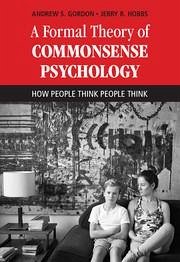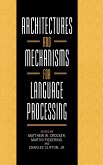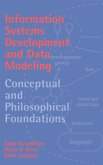Andrew S Gordon, Jerry R Hobbs
A Formal Theory of Commonsense Psychology
How People Think People Think
Andrew S Gordon, Jerry R Hobbs
A Formal Theory of Commonsense Psychology
How People Think People Think
- Gebundenes Buch
- Merkliste
- Auf die Merkliste
- Bewerten Bewerten
- Teilen
- Produkt teilen
- Produkterinnerung
- Produkterinnerung
This book formalizes commonsense knowledge to enable artificial intelligence to understand and engage with the mental lives of people.
Andere Kunden interessierten sich auch für
![Hci Related Papers of Interacción 2004 Hci Related Papers of Interacción 2004]() Raquel Navarro-Prieto / Jesús Lorés-Vidal (eds.)Hci Related Papers of Interacción 2004151,99 €
Raquel Navarro-Prieto / Jesús Lorés-Vidal (eds.)Hci Related Papers of Interacción 2004151,99 €![Affective Information Processing Affective Information Processing]() Jianhua Tao / Tieniu N. Tan (eds.)Affective Information Processing38,99 €
Jianhua Tao / Tieniu N. Tan (eds.)Affective Information Processing38,99 €![Intelligence Analysis as Discovery of Evidence, Hypotheses, and Arguments Intelligence Analysis as Discovery of Evidence, Hypotheses, and Arguments]() Gheorghe TecuciIntelligence Analysis as Discovery of Evidence, Hypotheses, and Arguments68,99 €
Gheorghe TecuciIntelligence Analysis as Discovery of Evidence, Hypotheses, and Arguments68,99 €![Similar Languages, Varieties, and Dialects Similar Languages, Varieties, and Dialects]() Similar Languages, Varieties, and Dialects79,99 €
Similar Languages, Varieties, and Dialects79,99 €![Architectures and Mechanisms for Language Processing Architectures and Mechanisms for Language Processing]() Architectures and Mechanisms for Language Processing128,99 €
Architectures and Mechanisms for Language Processing128,99 €![Information Systems Development and Data Modeling Information Systems Development and Data Modeling]() Rudy A. HirschheimInformation Systems Development and Data Modeling129,99 €
Rudy A. HirschheimInformation Systems Development and Data Modeling129,99 €![ACTA Numerica 2022: Volume 31 ACTA Numerica 2022: Volume 31]() ACTA Numerica 2022: Volume 31232,99 €
ACTA Numerica 2022: Volume 31232,99 €-
-
-
This book formalizes commonsense knowledge to enable artificial intelligence to understand and engage with the mental lives of people.
Produktdetails
- Produktdetails
- Verlag: Cambridge University Press
- Seitenzahl: 584
- Erscheinungstermin: 7. September 2017
- Englisch
- Abmessung: 265mm x 187mm x 35mm
- Gewicht: 1197g
- ISBN-13: 9781107151000
- ISBN-10: 1107151007
- Artikelnr.: 48822804
- Herstellerkennzeichnung
- Libri GmbH
- Europaallee 1
- 36244 Bad Hersfeld
- gpsr@libri.de
- Verlag: Cambridge University Press
- Seitenzahl: 584
- Erscheinungstermin: 7. September 2017
- Englisch
- Abmessung: 265mm x 187mm x 35mm
- Gewicht: 1197g
- ISBN-13: 9781107151000
- ISBN-10: 1107151007
- Artikelnr.: 48822804
- Herstellerkennzeichnung
- Libri GmbH
- Europaallee 1
- 36244 Bad Hersfeld
- gpsr@libri.de
Andrew S. Gordon is Research Associate Professor of Computer Science and Director of Interactive Narrative Research at the Institute for Creative Technologies at the University of Southern California. His research advances technologies for automatically analyzing and generating narrative interpretations of experiences. A central aim of his research is the large-scale formalization of commonsense knowledge, and reasoning with these formalizations using logical abduction. He is the author of the 2004 book, Strategy Representation: An Analysis of Planning Knowledge.
Part I. Commonsense Psychology: 1. Commonsense psychology and psychology
2. Commonsense psychology and computers
3. Formalizing commonsense psychology
4. Commonsense psychology and language
Part II. Background Theories: 5. Eventualities and their structure
6. Traditional set theory
7. Substitution, typical elements, and instances
8. Logic reified
9. Functions and sequences
10. Composite entities
11. Defeasibility
12. Scales
13. Arithmetic
14. Change of state
15. Causality
16. Time
17. Event structure
18. Space
19. Persons
20. Modality
Part III. Commonsense Psychology Theories: 21. Knowledge management
22. Similarity comparisons
23. Memory
24. Envisioning
25. Explanation
26. Managing expectations
27. Other agent reasoning
28. Goals
29. Goal themes
30. Threats and threat detection
31. Plans
32. Goal management
33. Execution envisionment
34. Causes of failure
35. Plan elements
36. Planning modalities
37. Planning goals
38. Plan construction
39. Plan adaptation
40. Design
41. Decisions
42. Scheduling
43. Monitoring
44. Execution modalities
45. Execution control
46. Repetitive execution
47. Mind-body interaction
48. Observation of plan executions
49. Emotions.
2. Commonsense psychology and computers
3. Formalizing commonsense psychology
4. Commonsense psychology and language
Part II. Background Theories: 5. Eventualities and their structure
6. Traditional set theory
7. Substitution, typical elements, and instances
8. Logic reified
9. Functions and sequences
10. Composite entities
11. Defeasibility
12. Scales
13. Arithmetic
14. Change of state
15. Causality
16. Time
17. Event structure
18. Space
19. Persons
20. Modality
Part III. Commonsense Psychology Theories: 21. Knowledge management
22. Similarity comparisons
23. Memory
24. Envisioning
25. Explanation
26. Managing expectations
27. Other agent reasoning
28. Goals
29. Goal themes
30. Threats and threat detection
31. Plans
32. Goal management
33. Execution envisionment
34. Causes of failure
35. Plan elements
36. Planning modalities
37. Planning goals
38. Plan construction
39. Plan adaptation
40. Design
41. Decisions
42. Scheduling
43. Monitoring
44. Execution modalities
45. Execution control
46. Repetitive execution
47. Mind-body interaction
48. Observation of plan executions
49. Emotions.
Part I. Commonsense Psychology: 1. Commonsense psychology and psychology
2. Commonsense psychology and computers
3. Formalizing commonsense psychology
4. Commonsense psychology and language
Part II. Background Theories: 5. Eventualities and their structure
6. Traditional set theory
7. Substitution, typical elements, and instances
8. Logic reified
9. Functions and sequences
10. Composite entities
11. Defeasibility
12. Scales
13. Arithmetic
14. Change of state
15. Causality
16. Time
17. Event structure
18. Space
19. Persons
20. Modality
Part III. Commonsense Psychology Theories: 21. Knowledge management
22. Similarity comparisons
23. Memory
24. Envisioning
25. Explanation
26. Managing expectations
27. Other agent reasoning
28. Goals
29. Goal themes
30. Threats and threat detection
31. Plans
32. Goal management
33. Execution envisionment
34. Causes of failure
35. Plan elements
36. Planning modalities
37. Planning goals
38. Plan construction
39. Plan adaptation
40. Design
41. Decisions
42. Scheduling
43. Monitoring
44. Execution modalities
45. Execution control
46. Repetitive execution
47. Mind-body interaction
48. Observation of plan executions
49. Emotions.
2. Commonsense psychology and computers
3. Formalizing commonsense psychology
4. Commonsense psychology and language
Part II. Background Theories: 5. Eventualities and their structure
6. Traditional set theory
7. Substitution, typical elements, and instances
8. Logic reified
9. Functions and sequences
10. Composite entities
11. Defeasibility
12. Scales
13. Arithmetic
14. Change of state
15. Causality
16. Time
17. Event structure
18. Space
19. Persons
20. Modality
Part III. Commonsense Psychology Theories: 21. Knowledge management
22. Similarity comparisons
23. Memory
24. Envisioning
25. Explanation
26. Managing expectations
27. Other agent reasoning
28. Goals
29. Goal themes
30. Threats and threat detection
31. Plans
32. Goal management
33. Execution envisionment
34. Causes of failure
35. Plan elements
36. Planning modalities
37. Planning goals
38. Plan construction
39. Plan adaptation
40. Design
41. Decisions
42. Scheduling
43. Monitoring
44. Execution modalities
45. Execution control
46. Repetitive execution
47. Mind-body interaction
48. Observation of plan executions
49. Emotions.








